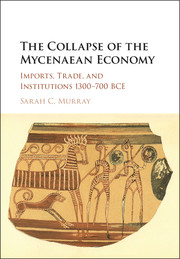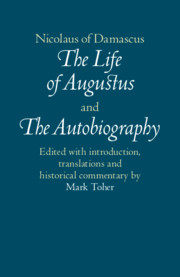Refine search
Actions for selected content:
23989 results in Ancient history
Chapter 1 - Empires, Diasporas and the Emergence of Religions
- from Part I - Contexts
-
-
- Book:
- Christianity in the Second Century
- Published online:
- 04 May 2017
- Print publication:
- 15 May 2017, pp 25-38
-
- Chapter
- Export citation
Bibliography
-
- Book:
- Christianity in the Second Century
- Published online:
- 04 May 2017
- Print publication:
- 15 May 2017, pp 309-348
-
- Chapter
- Export citation
Chapter 6 - Continuity and Change in Second-Century Christianity
- from Part II - Discerning Continuity and Discontinuity in Early Christianity
-
-
- Book:
- Christianity in the Second Century
- Published online:
- 04 May 2017
- Print publication:
- 15 May 2017, pp 106-121
-
- Chapter
- Export citation
Chapter 2 - The Mediterranean Jewish Diaspora in the Second Century
- from Part I - Contexts
-
-
- Book:
- Christianity in the Second Century
- Published online:
- 04 May 2017
- Print publication:
- 15 May 2017, pp 39-56
-
- Chapter
- Export citation

The Collapse of the Mycenaean Economy
- Imports, Trade, and Institutions 1300–700 BCE
-
- Published online:
- 12 May 2017
- Print publication:
- 24 April 2017

Nicolaus of Damascus: The Life of Augustus and The Autobiography
- Edited with Introduction, Translations and Historical Commentary
-
- Published online:
- 11 May 2017
- Print publication:
- 22 December 2016
Appendix 3 - Three Table of Incidence of Laws Concerning Parenting
-
- Book:
- Marriage, Sex and Death
- Published by:
- Amsterdam University Press
- Published online:
- 12 December 2020
- Print publication:
- 11 May 2017, pp 215-216
-
- Chapter
- Export citation
Frontmatter
-
- Book:
- Marriage, Sex and Death
- Published by:
- Amsterdam University Press
- Published online:
- 12 December 2020
- Print publication:
- 11 May 2017, pp 1-4
-
- Chapter
- Export citation
Conclusions
-
- Book:
- Marriage, Sex and Death
- Published by:
- Amsterdam University Press
- Published online:
- 12 December 2020
- Print publication:
- 11 May 2017, pp 201-204
-
- Chapter
- Export citation
3 - Adultery
-
- Book:
- Marriage, Sex and Death
- Published by:
- Amsterdam University Press
- Published online:
- 12 December 2020
- Print publication:
- 11 May 2017, pp 112-122
-
- Chapter
- Export citation
Appendix 2 - Table of Incidence of Laws Concerning Betrothal and Marriage
-
- Book:
- Marriage, Sex and Death
- Published by:
- Amsterdam University Press
- Published online:
- 12 December 2020
- Print publication:
- 11 May 2017, pp 214-214
-
- Chapter
- Export citation
Conclusions to Part 1
-
- Book:
- Marriage, Sex and Death
- Published by:
- Amsterdam University Press
- Published online:
- 12 December 2020
- Print publication:
- 11 May 2017, pp 83-84
-
- Chapter
- Export citation
2 - Consent to Betrothal
-
- Book:
- Marriage, Sex and Death
- Published by:
- Amsterdam University Press
- Published online:
- 12 December 2020
- Print publication:
- 11 May 2017, pp 41-50
-
- Chapter
- Export citation
4 - Having Children
-
- Book:
- Marriage, Sex and Death
- Published by:
- Amsterdam University Press
- Published online:
- 12 December 2020
- Print publication:
- 11 May 2017, pp 57-64
-
- Chapter
- Export citation
Abbreviations
-
- Book:
- Marriage, Sex and Death
- Published by:
- Amsterdam University Press
- Published online:
- 12 December 2020
- Print publication:
- 11 May 2017, pp 11-12
-
- Chapter
- Export citation
4 - The Nurturing Mother
-
- Book:
- Marriage, Sex and Death
- Published by:
- Amsterdam University Press
- Published online:
- 12 December 2020
- Print publication:
- 11 May 2017, pp 173-183
-
- Chapter
- Export citation
6 - Parents and Adult Children
-
- Book:
- Marriage, Sex and Death
- Published by:
- Amsterdam University Press
- Published online:
- 12 December 2020
- Print publication:
- 11 May 2017, pp 189-197
-
- Chapter
- Export citation
5 - Parents and Betrothal
-
- Book:
- Marriage, Sex and Death
- Published by:
- Amsterdam University Press
- Published online:
- 12 December 2020
- Print publication:
- 11 May 2017, pp 184-188
-
- Chapter
- Export citation
5 - Family Planning
-
- Book:
- Marriage, Sex and Death
- Published by:
- Amsterdam University Press
- Published online:
- 12 December 2020
- Print publication:
- 11 May 2017, pp 65-82
-
- Chapter
- Export citation
3 - Betrothal, Desire, and Emotional Attachment
-
- Book:
- Marriage, Sex and Death
- Published by:
- Amsterdam University Press
- Published online:
- 12 December 2020
- Print publication:
- 11 May 2017, pp 51-56
-
- Chapter
- Export citation
